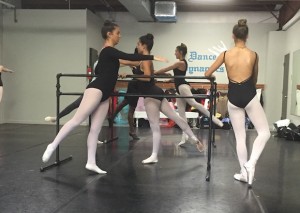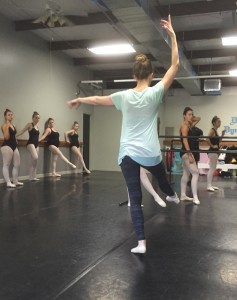 A lot of girls take dance as youngsters, but as they grow up into middle and high school, they seem to choose more traditional school-based team sports for their activities. And what about the boys?
A lot of girls take dance as youngsters, but as they grow up into middle and high school, they seem to choose more traditional school-based team sports for their activities. And what about the boys?
Dance promises significant benefits for both body and mind for boys and girls.
I recently spent some time with Little Rock dance teacher and ballerina Rebecca Mala, who teaches at Dance Dynamics studio. She teaches ballet to 3- to 5-year-olds, 6- to 8-year-olds and 10- to 12-year-olds, as well as ballet levels from junior through senior. She also teaches contemporary and lyrical dance classes for students 12 to 15 and up.
Mala not only knows the benefits first-hand from her own ballet career, but she sees the results in her students now. Even for students who aren’t future prima ballerinas or company soloists, the benefits of dance are “tremendous,” said Mala.
“Besides teaching discipline and dedication to learning the technique, it allows the student to increase appreciation for the art of dance and classical music,” she said. Students also express themselves in a positive way and learn how to release energy constructively. “It’s a great release when they’ve had a hard day at school or at home, it’s an outlet for expression in a positive way.”
Dancer Payton Davis, a student at Little Rock Christian Academy, used to dance and play basketball, but she had to make a choice due to the time-consuming nature of both activities.
“When I was thinking of the choice, and I thought of what I loved more, I knew I loved the performance aspect of dance,” she said. “I love hitting the stage, the nervousness and the excitement that goes on. It’s a great thing to feel. Some people think the trophies and the awards would motivate you, but it’s just going out there to perform and to know that I did my best with everyone else.”
The owner of Dance Dynamics, Latisha Welch, said that many of her dance students go on to excel in other fields, from astrophysics to sports trainers. She’s heard from former students who go on to their ultimate career fields, thanking her for teaching them not only dance, but also the importance of hard work, teamwork, confidence and time management.
“They had no idea all the life lessons they were learning while taking dance,” said Welch. To succeed, she said, students need “hard work, discipline and confidence.” She thinks no matter what students want to do in life, dance classes will prepare them for success.
Of course, the friendships built in the studio are a big part of the good that comes from dance education, not just with students but also with the teachers. Mala loves the opportunities to mentor her students. “I love encouraging them to express themselves through dance and to inspire each other through dance!”
but also with the teachers. Mala loves the opportunities to mentor her students. “I love encouraging them to express themselves through dance and to inspire each other through dance!”
Davis also values her dance-studio friends. They are the ones who know that having dance for three hours means three hours of strenuous exertion, rehearsals and serious sweat.
The kinds of dance offer different rewards as well. Mala said studying different styles makes students more versatile as performers. They may also find an area they love enough to pursue after high school, and lessons will help them be stronger competitors for scholarships and slots with dance companies.
Let’s be clear: We’re not just talking about little girls in pink tutus. Boys can benefit from ballet and other forms of dance, as well.
“It helps them gain flexibility, rhythm and strength in jumps,” said Mala. “Ballet is great because it’s a good blend of grace and athleticism.”
But Mala allows that it can be difficult for boys to pursue ballet and dance, even when they are naturals with significant talent and aptitude. “They are afraid they may get made fun of for having to wear tights and take classes with mainly girls,” she said.
But Mala hopes this will change. “There are many strong male ballet dancers who debunk the myth that ballet is just for girls.” There are so many physical and mental benefits, Mala thinks boys shouldn’t eliminate it from consideration.
Welch thinks this stigma is stronger in the South, where parents somewhat automatically enroll their girls in dance and their boys in sports.
“In other countries, ballet is considered a much more prestigious job, along the lines of actors,” she said. “In the United States, sports are considered more important because they make more money.”
 RJ Anderson, 16, is a Pulaski Academy student, who studies with Mala and Welch at Dance Dynamics. He knows the vision people have of dance classes does not square with reality, especially for boys.
RJ Anderson, 16, is a Pulaski Academy student, who studies with Mala and Welch at Dance Dynamics. He knows the vision people have of dance classes does not square with reality, especially for boys.
“They basically see this picture of all the girls in pink tutus. That’s all they see,” he said. “But in reality, it’s much more than that. You have to respect the art form. You have to stay true to yourself and open your eyes to possibilities (like dance)… ballet, jazz, hip hop, whatever it is.”
Anderson loved dancing, but it wasn’t until he got formal instruction that he really dedicated himself to it. He said he doesn’t like to “be amongst the norm,” and he challenges all students to just try a dance class, not to be afraid to fail and to be open to what they could learn.
He said he’s learned time management, due to the demanding practice schedules, as well as discipline to learn exacting technique. Whether he dances or does something else as a career, he knows those skills will help him succeed.
Davis said her friends who don’t dance don’t understand how much time it takes to be good at dance. “They think that we’re just girly-girls and that we don’t work hard,” she said. “It’s hard-at-it practice every day after school.” She said the teachers are there to guide students’ technique and to encourage them, but students have to have the drive and focus within them to succeed. “I don’t think people realize the amount of hard work that comes from within and that you have to put in every single day.”
Davis agreed with Anderson about the importance of time management for dance students. She said she’s learned to focus on what she is doing at the time, home work, dance or school, in order to succeed at each thing. But she really enjoys the different people who come together in a dance class. Students from various schools dance with her, students she wouldn’t know otherwise.
But Welch said that even if sports are the end goal, ballet is a stepping stone. “Many football and soccer coaches are beginning to see and understand the benefits of such training,” she said, listing flexibility, agility and general knowledge of muscle work and function.
And dance and sports have something else in common, said Welch. “While a ballet dancer only shows the audience the perfected pirouette and elegant lines of an arabesque, the audience never sees the grueling training that goes on behind the curtain … not unlike the many hours an athlete spends training for the big game.”
Everyone can benefit from dance classes and pursuing the study of it seriously, said Mala. “Dancing allows the dancer to just let go and get lost in the music. The studio is a safe place for the dancers to just forget about any problems and dance their hearts out.”
Mala knows from her own dancing years that dance kept her in the studio…when other kids were partying and drinking on the weekends.
“I always had classes and rehearsals on Fridays through Sundays,” she said. “But I loved it and wouldn’t want to be anywhere else. I missed a few things like football games, but that was my choice.”
“There is nothing more powerful than being able to just let go and learn how to channel your emotions into movement,” Mala said. “It’s definitely liberating and fulfilling on so many levels.”













